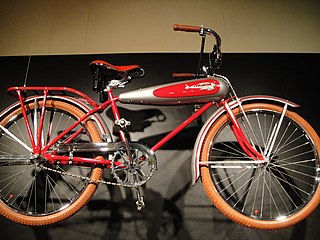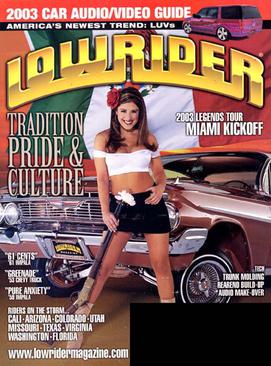
Chicano, Chicana, is an identity for Mexican Americans who have a non-Anglo self-image. Chicano was originally a classist and racist slur used toward low-income Mexicans that was reclaimed in the 1940s among youth who belonged to the Pachuco and Pachuca subculture. In the 1960s, Chicano was widely reclaimed in the building of a movement toward political empowerment, ethnic solidarity, and pride in being of indigenous descent. Chicano developed its own meaning separate from Mexican American identity. Youth in barrios rejected cultural assimilation into whiteness and embraced their own identity and worldview as a form of empowerment and resistance. The community forged an independent political and cultural movement, sometimes working alongside the Black power movement.

BMX, an abbreviation for bicycle motocross or bike motocross, is a cycle sport performed on BMX bikes, either in competitive BMX racing or freestyle BMX, or else in general street or off-road recreation.

A lowrider or low rider is a customized car with a lowered body that emerged among Mexican American youth in the 1940s. Lowrider also refers to the driver of the car and their participation in lowrider car clubs, which remain a part of Chicano culture and have since expanded internationally. These customized vehicles are also artworks, generally being painted with intricate, colorful designs, unique aesthetic features, and rolling on wire-spoke wheels with whitewall tires.

The King & Story, also known as Story & King, neighborhood of San Jose, California is located in the Alum Rock district of East San Jose, centered on the intersection of King and Story roads. King & Story is one of San Jose's most notable and historic Chicano/Mexican-American neighborhoods.

An auto show, also known as a motor show or car show, is a public exhibition of current automobile models, debuts, concept cars, or out-of-production classics. It is attended by automotive industry representatives, dealers, auto journalists and car enthusiasts. Most auto shows occur once or twice a year. They are important to car manufacturers and local dealers as a public relations exercise, as they advertise new products and promote auto brands. The five most prestigious auto shows, sometimes called the "Big Five", are generally considered to be held in Frankfurt, Geneva, Detroit, Paris and Tokyo. Car enthusiast communities along the historic U.S. Route 66 are credited with general popularization of car meets, including ethnic groups such as the Hispanos of New Mexico, Chicanos, and Mexican-Americans of the Southwestern United States; lowrider, high technology, electric vehicle, and other enthusiast show, are popular in Los Angeles, Las Vegas, Albuquerque, San Francisco, and Chicago for this reason.

The Schwinn Bicycle Company is an American company that develops, manufactures and markets bicycles under the eponymous brand name. The company was originally founded by Ignaz Schwinn (1860–1948) in Chicago in 1895. It became the dominant manufacturer of American bicycles through most of the 20th century. After declaring bankruptcy in 1992, Schwinn has since been a sub-brand of Pacific Cycle, owned by the Dutch conglomerate, Pon Holdings.

Kustom Kulture is the artworks, vehicles, hairstyles, and fashions of those who have driven and built custom cars and motorcycles in the United States of America from the 1950s through today. It was born out of the hot rod culture of Southern California of the 1960s.

The Huffy Corporation is a supplier of bicycles with headquarters in Dayton, Ohio, United States.

Cruising is a social activity that primarily consists of driving a car. Cruising can be an expression of the freedom of possessing a driver's license. Cruising is distinguished from regular driving by the social and recreational nature of the activity, which is characterized by an impulsively random, often aimless course. A popular route is often the focus of cruising. "Cruise nights" are evenings during which cars drive slowly. A cruise can be a meeting of car enthusiasts at a predetermined location, organised predominantly through the internet but also largely through mobile phone, word of mouth or simply by a cruise being established enough that it becomes a regular event.
Caló is an argot or slang of Mexican Spanish that originated during the first half of the 20th century in the Southwestern United States. It is the product of zoot-suit pachuco culture that developed in the 1930s and '40s in cities along the US/Mexico border.

A cruiser bicycle, also known as a beach cruiser or (formerly) motobike, is a bicycle that usually combines balloon tires, an upright seating posture, a single-speed drivetrain, and straightforward steel construction with expressive styling. Cruisers are popular among casual bicyclists and vacationers because they are very stable and easy to ride, but their heavy weight and balloon tires tend to make them rather slow. Another common feature is their ability to be customized with accessories including fenders, lights and saddle bags. They are designed for use primarily on paved roads, low speeds/distances, and are included in the non-racing/non-touring class and heavyweight or middleweight styles of the road bicycle type.

Lowrider was an American automobile magazine, focusing almost exclusively on the style known as a lowrider. It first appeared in 1977, produced out of San Jose, California, by a trio of San Jose State students. In 2007, it was published out of Anaheim, California, and part of the Motor Trend Group. The magazine was closed in December 2019.
As with many consumer products, early bicycles were purchased solely for their usefulness or fashionableness and discarded as they wore out or were replaced by newer models. Some items were thrown into storage and survived, but many others went to the scrapyard. Decades later, those with an interest in cycling and history began to seek out older bikes, collecting different varieties. Like other forms of collecting, bike collectors can be completists or specialists, and many have extensive holdings in bike parts or literature, in addition to complete bicycles.

A bicycle handlebar is the steering control for bicycles. It is the equivalent of a tiller for vehicles and vessels, as it is most often directly mechanically linked to a pivoting front wheel via a stem which in turn attaches it to the fork. Besides steering, handlebars also often support a portion of the rider's weight, depending on their riding position, and provide a convenient mounting place for brake levers, shift levers, cyclocomputers, bells, etc.

A wheelie bike, also called a dragster, muscle bike, high-riser, spyder bike or banana bike, is a type of stylized children's bicycle designed in the 1960s to resemble a chopper motorcycle and characterized by ape hanger handlebars, a banana seat with sissy bar, and small wheels. Notable examples include the Schwinn Sting-Ray and Krate lines and the Raleigh Chopper line. Other notable manufacturers and retailers that offered models include AMF, CCM, Columbia, Huffy, Iverson, J. C. Penney, Malvern Star, Monark, Murray, Ross, Sears, and Vindec.

The Chicano Art Movement represents groundbreaking movements by Mexican-American artists to establish a unique artistic identity in the United States. Much of the art and the artists creating Chicano Art were heavily influenced by Chicano Movement which began in the 1960s.

Whittier Boulevard is an arterial street that runs from the Los Angeles River to Brea, California. The street is one of the main thoroughfares in both Whittier and East Los Angeles. At various times, portions of Whittier Boulevard carried the designation of U.S. Route 101. Whittier Boulevard also carries a portion of El Camino Real. Its west section leading from the Sixth Street Viaduct was demolished in 2016. Currently, Whittier Boulevard carries two Caltrans controlled highways. The portion between Rosemead Boulevard and Beach Boulevard carries State Route 72 and the portion between Beach and Harbor Boulevards carries California State Route 39. The portion of State Route 72 up to State Route 19 was relinquished back to Pico Rivera in the early 2000s and the portion of State Route 72 between State Route 19 and Downey Road was deleted from SR 72 in 1992.
Chicano Art: Resistance and Affirmation was a traveling exhibit of Chicano/a artists which toured the United States from 1990 through 1993. CARA visited ten major cities and featured over 128 individual works by about 180 different Chicano/a artists. The show was also intended to visit Madrid and Mexico City. CARA was the first time a Chicano exhibit received major attention from the press and it was the first exhibit that collaborated between Chicanos and major museums in the U.S. The show was considered a "notable event in the development of Chicano art." Another unique feature of CARA was the "extensive planning" that attempted to be as inclusive as possible and which took place more than five years prior to the opening at Wight Art Gallery.
A Mexican American is a resident of the United States who is of Mexican descent. Mexican American-related topics include the following:
Jesse Valadez was a Mexican American lowrider and artist based in East Los Angeles who became known as a major figure in lowriding, a cultural practice among Chicanos that he helped pioneer. He was a founding member of the Imperials car club and designed the famous Gypsy Rose lowrider in the 1970s, which went on to make international waves for lowrider culture, boosted by its feature on the show Chico and the Man.






















